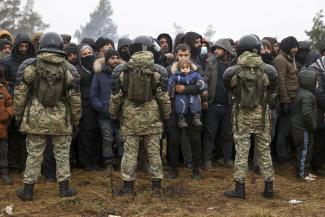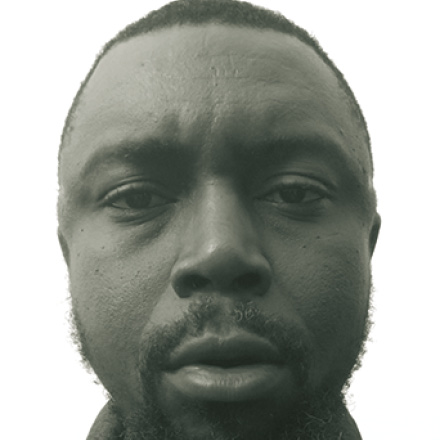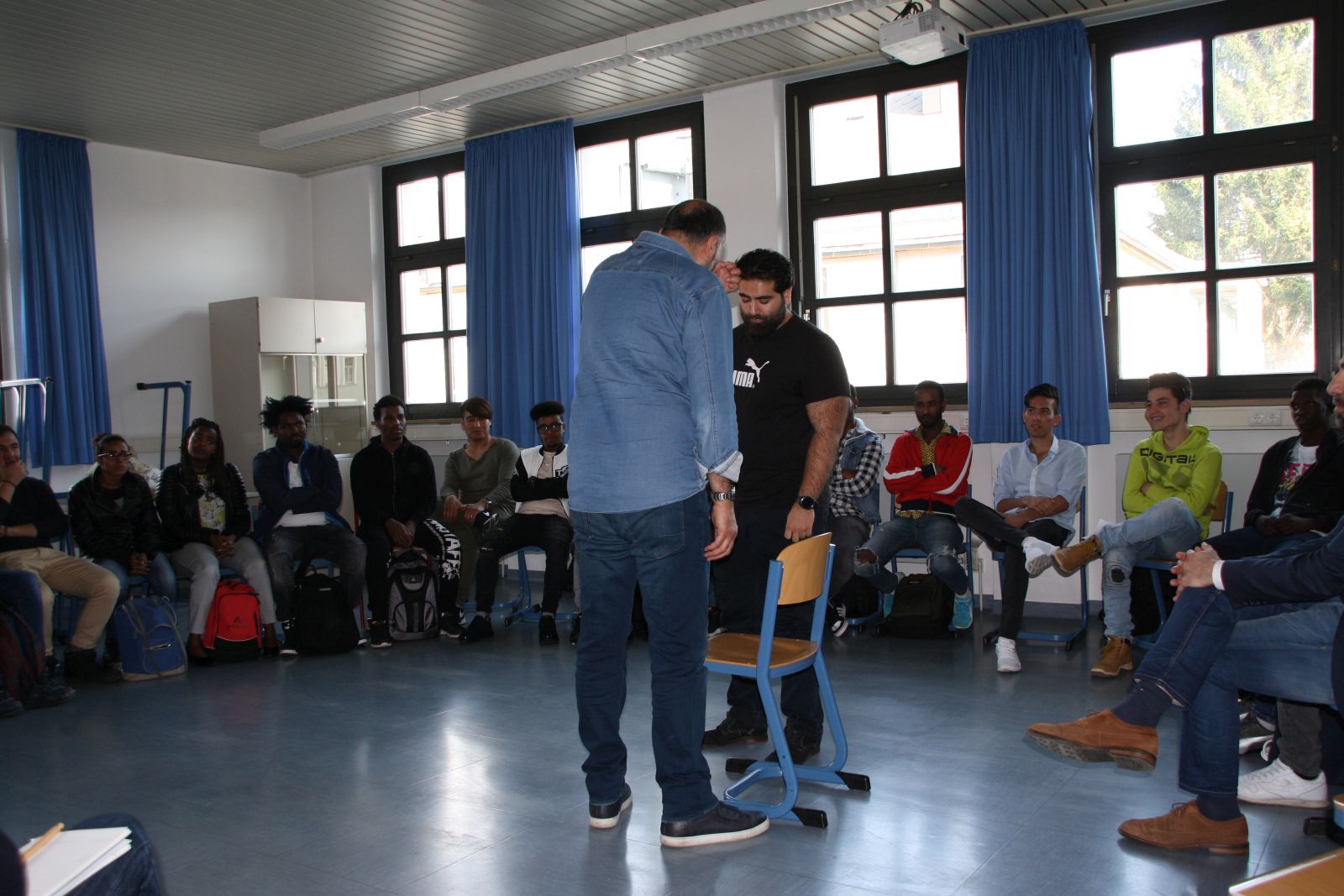Polish border crisis
“There are viable and humane solutions”

Is Belarusian strongman Lukashenko’s strategy working?
Yes, look at what he achieved already, since he announced this summer that he would no longer stop people who want to get to the EU. His state is now smuggling people. With a few thousand people on the border – and at the cost of an unknown number of lives – he has forced the EU to negotiate with him again as the effective ruler in Minsk. At the same time, he is repressing his own people increasingly hard. The EU is building a fence, even preventing Belarusian dissidents from reaching safety. The images of a few thousand irregular migrants have generated fear and provoked the Polish government to respond harshly. That in turn allowed Belarusian TV to show EU hypocrisy and brutality. By making use of a few thousand people – and even taking money from them – he caused the EU to breach its own principles.
So Poland is responding as he expected?
Well, also other countries have used force in violation of EU law on the EU’s external borders in recent years. That happened on the Greek-Turkish border in February 2020, when the EU-Turkey cooperation collapsed. It had happened before on Croatia’s border with Bosnia, where violence has been used for years in attempts to block irregular migration. Hungary has even legalised border pushbacks – forced returns of migrants entering a country – in 2016 and continues this practice even though the European Court of Justice declared it to be illegal in December 2020. The disturbing reality is that EU law is being broken today on many of its external borders. In Poland, the situation is compounded by the fact that the government is under pressure anyway. It only wants one thing from the EU – political support for its harsh policy. That is what it received, while even rejecting support from Frontex, the EU agency which has its headquarters in Warsaw. Poland denied aid agencies and the media access to the border area, while accusing the Polish opposition of being weak and compounding the problems. This crisis served as a perfect distraction from other issues. After all, the EU is accusing Poland’s government of undermining the independence of its judiciary and breaking EU law. On the border, however, other member states now support illegal action, considering it to be necessary. It is not hard to see how this scenario is useful for the Polish government. Respect of EU law now appears to be a matter of mere political convenience. That is what this government believes it should be anyway.
How can the EU escape this predicament?
The EU urgently needs an alternative and humane policy for controlling irregular migration, which does not break legal principles by resorting to force. In recent years, however, democratic governments have repeatedly felt that they had to choose between losing control of borders and regaining control by pushing back irregular migrants. Government after government has sacrificed the non-refoulement (no push-back) principle. That happened in Australia, the USA, Greece, Croatia and Poland. During the election campaign, US President Joe Biden has criticised the approach taken by his predecessor Donald Trump, but in office, he continued the policy of deporting irregular migrants without any asylum procedure. Most were sent to Mexico, some directly to Haiti. In fact, no US administration has ever sent more people back across the border without granting them any access to asylum procedures than the current one. In September 2021 alone, 100,000 people were affected. So many democracies are embracing such policies, that the principle of non-refoulment is being violated around the world. This principle is, however, at the core of the 1951 Refugee Convention. This trend is dramatic.
Please elaborate…
Governments are entitled to control their borders. They are also entitled to deport people who have no right to stay. However, democracies decided decades ago that they would only do so by following legal procedures. They adopted conventions: on refugees, on anti-torture, on the rights of children. Europe also has the European Convention on Human Rights and a Charter of Fundamental Rights. Now we see those fundamental rights being sacrificed. Under public pressure, governments feel that they need to choose between losing control or ignoring these rights. This is a trap. Democracies need humane ways of controlling borders without breaching fundamental rights. To make that happen, it does not suffice that media and non-governmental organisations describe shortcomings and suffering at borders. They have been doing that for years in regard to the terrible conditions of irregular migration from Libya for years. What is needed are tangible proposals for reducing irregular migration without pushbacks and human-rights breaches as well as convincing majorities that achieving that is worthwhile.
How can that be done?
There is a need for clear thinking. Regarding irregular migration on the border, governments have three options:
- They can keep borders open without trying to reduce irregular migration, as happened in some months of 2015.
- They can rely on border pushbacks, violence or bad treatment as a deterrent, as is happening in Poland now.
- Or they can conclude agreements with third countries to where migrants can be transferred after a pre-defined date and where they will be treated in a humane way and have the opportunity to apply for asylum. That was what the EU-Turkey deal was about.
The goal of such agreements is to reduce deadly irregular migration without violating human dignity or suspending the non-refoulement principle. There is no human right to migration, but there is a human right for people in need of protection not to be sent back into settings where they are potentially in danger. However, there is no right to choose the country which offers protection. Lukashenko’s strategy would have failed immediately, had the EU reached an agreement with a country outside the EU which would have allowed it to bring even a small number of refugees there. It would have become impossible to lure refugees to Belarus. However, why would any third country want to help the EU? Consider Ukraine, a country with ample problems of its own. When German politicians started taking about it as a potential partner, obvious questions arose immediately: Why us? What is our interest? The starting point for serious negotiations would be to consider what the EU can offer a country like Ukraine as an incentive to help.
That is how the EU-Turkey deal came about.
Yes, indeed. Turkey’s government made a proposal to the EU in March 2016. That was not blackmail, as is the case of Belarus today. Turkey was in a position similar to France today in regard to irregular migration to the UK. Turkey never invited Syrian refugees to come only to send them on to the EU. Most Syrian refugees have since remained in Turkey, which has become the country hosting the most refugees in the world. Smart diplomacy and cooperation improved the situation for millions of Syrians in Turkey, with € 6 billion being mobilised in their support. The death toll in the Aegean Sea fell by an annual 1,000. When this cooperation collapsed in 2020, we witnessed what some in the EU had considered to be the better alternative even in 2016: pushbacks at land and sea. The EU-Turkey statement had ruled them out. Now, some in the EU believe that the fate of millions of Syrians in Turkey need no longer concern them. The humane alternative to breaching fundamental rights is agreements with third countries.
It does not look as though the EU were working on such agreements. Are there tangible plans for cooperating with Ukraine?
Well, it takes a partner government that wants cooperation. The Turkish government proposed cooperation because it served its interests. Turkey did not need to do much to help the EU. The EU, including Germany, accepted the plan. Let’s assume the EU would offer Ukraine a special fund worth € 5 billion for upgrading its energy system and expanding the use of renewables. That would make the country less vulnerable to Russian pressure. Brussels and Kiev could talk about even closer integration into the EU’s single market. Member states could offer more tangible support in the case of a potential Russian aggression. In return, Ukraine would, from a certain date on, take in a small number of refugees who want to get from Belarus to Poland and Lithuania, whereas the EU would accept all those who currently are in Belarus. The humanitarian crisis would be over. There would be no need to negotiate with Lukashenko. Ukraine would be appreciated as a strategic partner of the EU. Cooperation would help both sides to counter blackmail attempts by Minsk and Moscow. However, such discussions have not taken place. Many in the EU found it easier to sacrifice the refugee convention than to make a serious and attractive proposal to another democracy.
In Germany, that would be the job of the newly formed government.
The new coalition treaty of the three parties that want to form the new Federal Government is very clear on what it wants to end: pushbacks, deaths at sea, suffering at borders. It states that the incoming government wants to protect the refugee convention and reduce irregular migration. But here is the crux: these things cannot be achieved without partners in the EU and beyond it. The crisis in Belarus shows that it is important to have more than lofty goals. There is a need for realistic and implementable plans. Good intentions must lead to serious diplomacy. Otherwise, even the best ideas and most noble ambitions will remain mere rhetoric.
Why is it not possible to distribute refugees among the EU states that are willing to accept them?
That would be a part of the plan, but no country – and that includes Germany – is currently prepared to take in an unlimited number of irregular migrants. Don’t forget how difficult it was to distribute families with children after last year’s devastating fire in the Moria refugee camp. Back then, the number of people in desperate need was actually quite small.
Labour-market experts say that Germany and other EU members urgently need immigration to sustain social-protection systems, including health care and nursing care. Isn’t it ironic that the EU is so vehemently rejecting people who want to come here?
Yes, indeed. Our societies need immigration, but that does not mean that they should arrive via deadly and irregular routes across the sea or through Belarusian forests. And when people get sense of a loss of control, that has a political impact beyond specific numbers. A humane approach would be to combine two things:
- reducing irregular migration without pushbacks, through cooperation with partners and legal repatriations and
- increasing regular migration and resettlements, legal ways to help people in need of protection.
The key is to open up safe routes to increase resettlement programmes. That is being discussed, including in Germany. The outgoing Federal Government set up a commission to assess causes of displacement (see box on Expert commission resports on our D+C/E+Z platform). It recommended that Germany should take in and resettle at least as many people per capita as Sweden. That would mean 40,000 in Germany annually. These people would be spared dangerous journeys at the hands of people smugglers. Instead, they would have the prospect of a regular status as residents. If France and others would join Germany in such an effort there would be 100,000 legal routes for refugees per year. If Canada and the US cooperate, the resettlement of 250,000 refugees a year would be perfectly feasible – and that would be a big step towards a humane refugee regime.
Do you expect the new Federal Government to take that approach?
Alas, the coalition agreement does not spell out any concrete number in regard to resettlements and legal routes for refugees. However, it does include the principle of replacing irregular with regular migration and expanding protection through legal ways. It now remains to be seen what these statements will mean in practice.
How will migration from Africa develop in the coming years? You have frequently cast doubt on the popular narrative of “mass invasion” or “floods of refugees”.
Yes, reckless politicians and writers keep propagating the myth of mass immigration from Africa and growing “migration pressure”. In truth, regular and irregular immigration figures have barely increased at all in recent years – despite Africa’s population growth. It is increasingly difficult for young Africans to get a visa or work permit. In fact, this trend should be reversed: Europe ought to increase regular migration, including for exchanges of students and scholars. At the same time, limited but deadly irregular migration to the EU should be further reduced through human-rights compatible agreements. Obstructing rescues at sea, as is happening in the Central Mediterranean, is not acceptable. 2021 has been a horrible year in this regard. A huge number of people have drowned and horrific human-rights violations occur in camps in Libya. The number of refugees from Africa who reach the EU is very small.
Do you see mass immigration from Africa to Europe as a possibility at some point?
No, I do not. What this narrative misses is a plain truth. The decisive factor that determine how many people manage to cross borders are governments’ border policies. When states abandon human rights and use force – as is happening around the world – refugees are shut out and irregular migration drops. In the past four years, the number of refugees who managed to cross borders around the globe was very small. This trend must be reversed, and the Mediterranean must not remain the world’s deadliest border. Germany’s incoming coalition government has spelled out this goal. It is feasible if real efforts are made. Reversing the current trends would be a historic achievement. With partners and determination, policymakers can make it happen.
Gerald Knaus is co-founder of the European Stability Initiative (ESI) think tank and author of the book „Welche Grenzen brauchen wir?“ (What borders do we need?).
www.esiweb.org
euz.editor@dandc.eu
Correction: 1 December 12:05 pm Frankfurt time: The original post stated that obstruction of sea rescues had been "agreed with Libya" which is facutally inaccurate. Obstruction is being practiced and tolerated without formal agreement. We apologise for this editorial mistake













